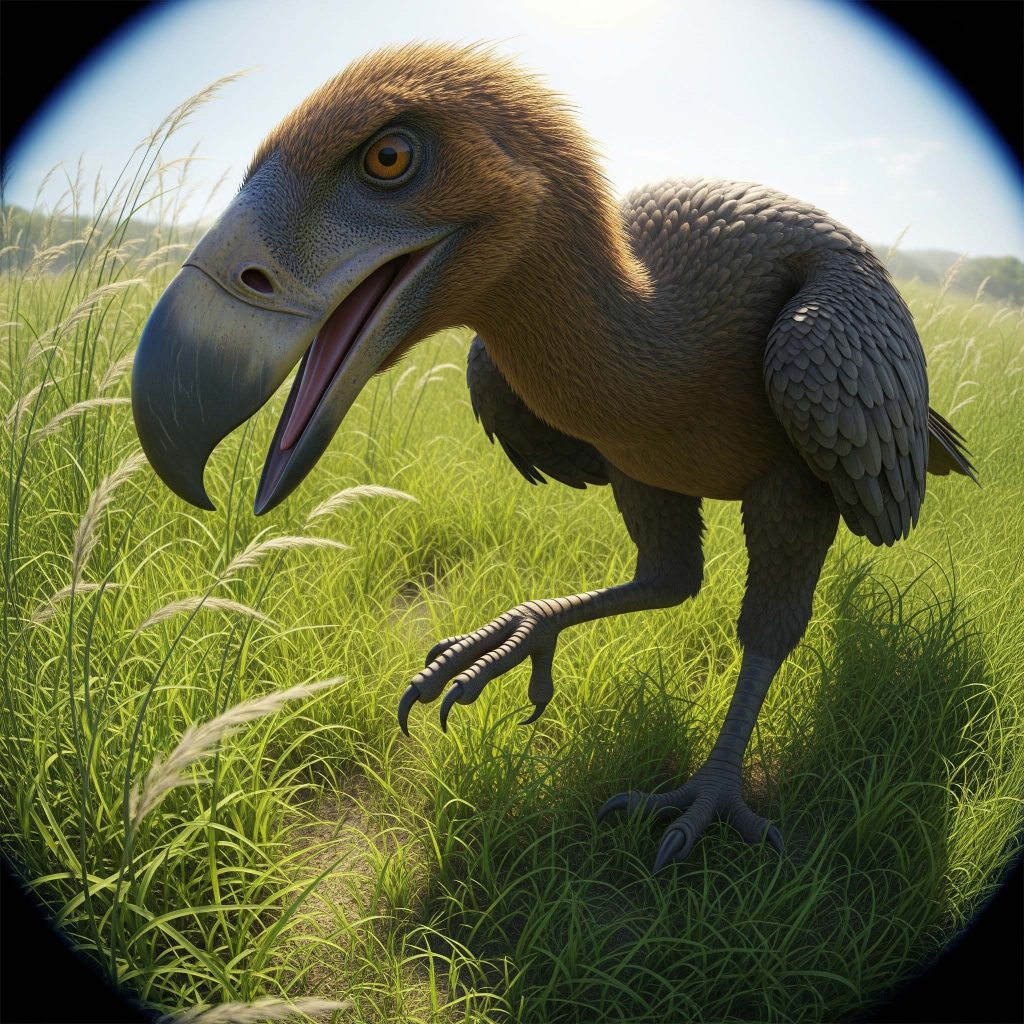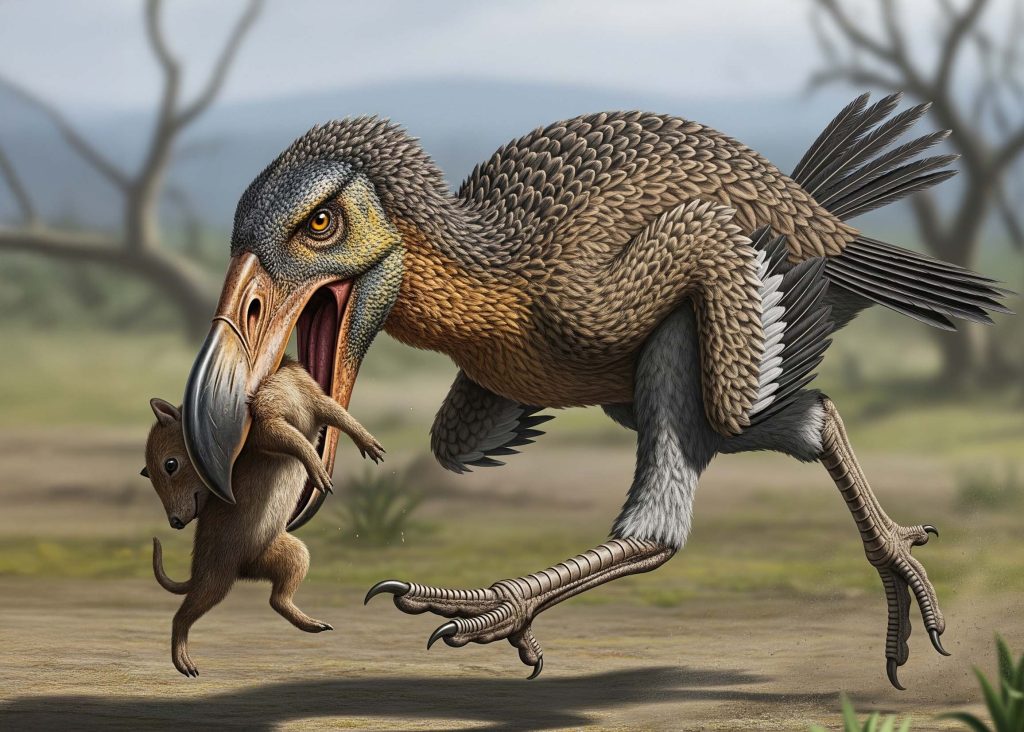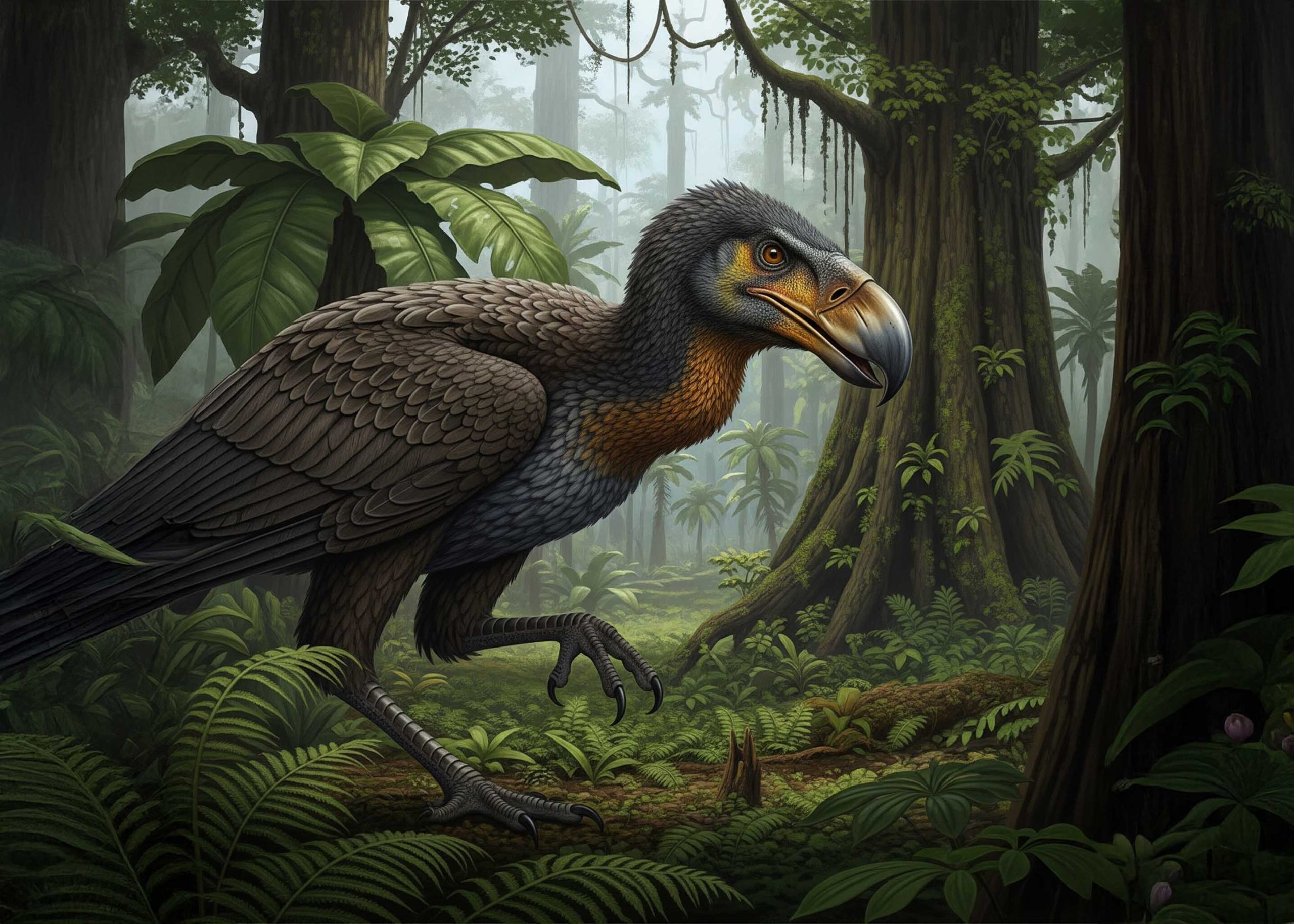Imagine a world where the biggest, scariest hunters weren’t lions, or bears, or even dinosaurs. Instead, they were giant, super-fast birds! This might sound like something from a fantasy movie, but it was real.
After the dinosaurs were wiped out 66 million years ago, the world was left without a dominant group of large predators. In the isolated continent of South America, a new and terrifying type of hunter evolved to take the top spot: the Phorusrhacids, more famously known as the “Terror Birds.”
For nearly 60 million years, these giant, flightless, carnivorous birds were the undisputed rulers of their domain. They were the kings and queens of ancient South America, and they were truly terrifying!
Don’t Miss This!
After reading, challenge yourself with our interactive quiz at the end. Click here to take the Quiz
Index

Depiction of Kelenken, one of the largest Terror Birds in ancient South America.
A Killer Built for Speed and Power
Terror birds were perfectly adapted for a life of hunting. They were fast, powerful, and armed with a truly formidable weapon. The largest species, like Kelenken, stood up to 3 meters (10 feet) tall—that’s taller than a basketball hoop! Imagine a bird that tall, running straight at you!
Here’s what made them such amazing hunters:
- The Skull and Beak: Their most terrifying feature was their massive skull, which could be up to 71 centimeters (28 inches) long. It was topped with a huge, hooked beak, similar to that of a modern eagle, but on a much larger scale. This beak was incredibly strong and sharp. Scientists believe they used it to deliver powerful, stabbing blows to their prey, like a giant pickaxe. They could also use it to tear flesh and crush bones.
- Speed and Agility: With long, powerful legs, terror birds were built for speed. They had strong muscles in their legs that allowed them to run incredibly fast. Scientists estimate they could run at speeds of up to 50 kilometers per hour (30 mph), which is as fast as a car in a neighborhood! This allowed them to chase down the fast-running mammals of the time, like early horses and giant rodents.
- Vestigial Wings: Their wings had shrunk to small, stubby appendages. They were useless for flying, but some scientists think they might have had sharp claws on them. These claws could have been used for grappling with prey, holding them down while the powerful beak delivered the killing blow.
- Sharp Eyesight: Like many predators, terror birds likely had excellent eyesight, helping them spot prey from a distance in the open grasslands where they hunted.
“For nearly 60 million years, these giant, flightless, carnivorous birds were the undisputed rulers of their domain.”
The End of a Reign
The terror birds thrived in South America for millions of years because it was an isolated continent. Imagine it like a giant island where they had no serious competition from other big predators. They were at the top of the food chain, and nothing could challenge them.
However, their long reign came to an end due to a major geological event: the formation of the Isthmus of Panama. This happened around 3 million years ago. The Isthmus of Panama is a narrow strip of land that connects North and South America. Before this, the two continents were separated by ocean.
When this land bridge formed, it triggered a massive biological event called the Great American Biotic Interchange. Animals from both continents began to migrate. This meant that new animals from North America, like saber-toothed cats (such as Smilodon) and giant bears, could now walk into South America.
Unfortunately for the terror birds, these new mammalian predators were very good hunters. They were often more agile, hunted in packs, and had different hunting strategies. It is believed that the terror birds were unable to compete with these new, highly efficient predators and were eventually driven to extinction. It was a tough competition, and the terror birds lost.
New Discoveries of Their Hunting Style
Scientists are always learning more about terror birds. One exciting area of research is trying to figure out exactly how they hunted. Their huge, hooked beaks were very strong, but they were also stiff. This means they probably didn’t bite and shake their prey like a crocodile or a T-Rex.
New studies, using computer models of their skulls, suggest that terror birds might have used their beaks like a giant axe or a pickaxe, delivering powerful, downward blows to stun or kill their prey. They might have grabbed their prey with their small, clawed wings and then used their beak to deliver a precise, deadly strike.
Another interesting discovery involves their hearing. Recent research on the inner ear bones of terror birds suggests they might have had very good low-frequency hearing. This means they could have heard the footsteps of large prey from far away, giving them an advantage in hunting.
“The terror birds are a spectacular example of how life adapts to fill empty ecological niches.”
A Legacy of Terror Birds
The terror birds are a spectacular example of how life adapts to fill empty ecological niches. When the dinosaurs disappeared, there was a big empty spot for a top predator, and these birds stepped right in. They show that the familiar roles of predator and prey are not always filled by the animals we might expect. For millions of years, in the lost world of South America, the top predator was not a mammal, or a reptile, but a giant, terrifying bird.
Their story is a fascinating chapter in the history of life, a reminder of the strange and wonderful forms that evolution can produce. It also teaches us about the importance of land bridges and how they can change the course of evolution by allowing different animals to meet and compete.

Terror Birds Quiz
How much do you know about the giant, predatory birds of South America?


Leave a Reply